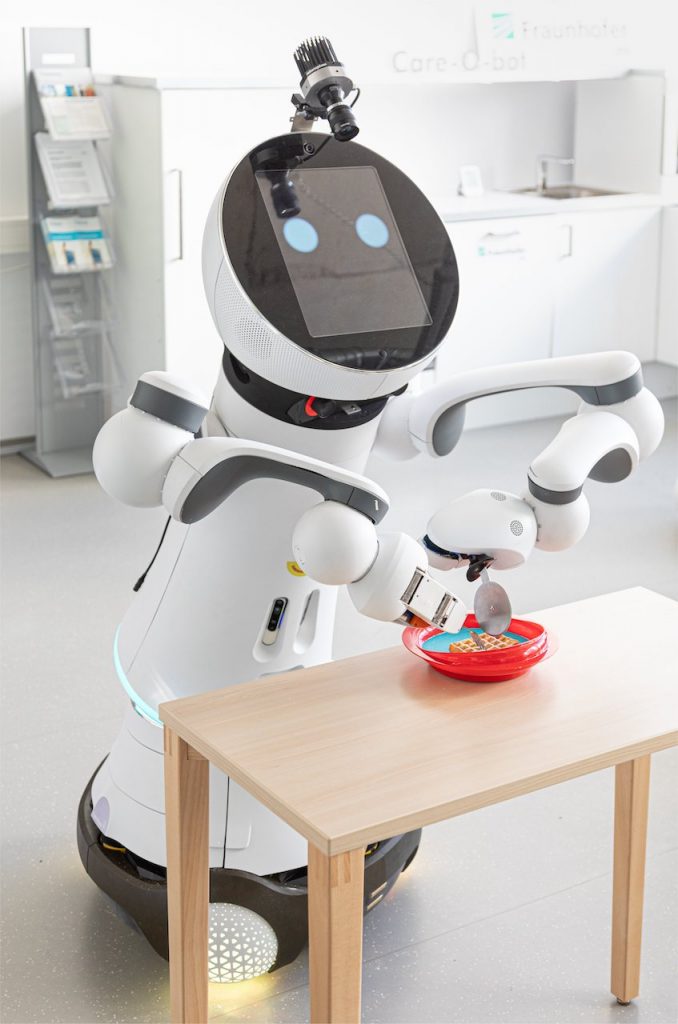Aged care is labour intensive; wages are often the largest single expense of aged care operators. Robots might take off some of the workload, leaving support workers more time to engage with the residents and undertake the personal care not possible for machines.
At least that is the thinking of the Japanese Ministry of Health, Labour and Welfare.
Two tasks that robots have been designed to undertake are transporting people from bed to wheelchair and helping paralysed people eat. Both of these are research projects and have not been used commercially.
The first is Robear, a patient care robot with a cute bear face designed to put patients at ease.
Robear is designed to lift elderly patients out of a fully or partially reclining position on a bed, and transfer them to a wheelchair.
It was developed a few years ago by the Robot Sensor Systems research team of Reiken in Japan.

Other robots, including RoPHa and My Spoon have been designed to offer bite sized pieces of food to residents. For healthcare institutions, feeding disabled residents take a considerable amount of time.
Researchers say these robots allow residents to eat at their own pace and according to their own preferences. They also eat more and better.
Specialised robots are useful, but a robot capable of a wide range of caring would be ideal.
Softbank Robotics have created Romeo a versatile robot with a humanoid design intended to assist the elderly as they experience cognitive and physical decline.
Romeo is programmed with a variety of physical tasks and interpersonal interactions aimed at helping elderly people live independently in their own homes for as long as possible.
Romeo can pick up and move objects, open doors, climb stairs and provide mobility assistance while a patient is walking. It can to identify if a patient has fallen and needs emergency services to be contacted.
The robot can also be programmed with specific care routines which are triggered by the time of day or by the patient’s request, and can respond to keywords and activities by asking questions and offering topics for discussion.
Romeo can even be set to detect a patient is napping and wake them, or offer food, drink and medications at prescribed intervals.
Fraunhofer-Gesellschaft, a research company in Stuttgart, Germany, has developed a range of versatile Care-o-bots that act as smart helpers.
These have been made available to other researchers to develop their own programs for application in areas such as households, hotels, care homes and hospitals. One application scenario for Care-O-bots is supporting aged care in nursing homes or supporting elderly people in their private homes.
One resident at Shintomi Nursing Home in Japan told the Japan Times that talking with a robot eased the anxiety of worrying about what the other person is thinking during conversations, making participants more inclined to speak freely and share feelings.
Professor Tal Oron-Gilad at Ben Gurion University in Israel and her team are working on ways to improve human interactions with robots in collaboration with Israeli, European and US robot builders.
“This means we are looking at many types of robots: mule-type robots that can carry and accompany older adults for safety and for carrying bags, groceries, tableware to the dining table or a hot dish,” she said.
“We are looking at robotic arms that can set a table, or help in the kitchen, and we are looking at telepresence robots that can serve as a remote eye, for example to explore the house for hazards such as an open window, a forgotten gas stove or a spill on the floor.
“Lastly we also looked at robots to encourage movement and physical exercises.”
Siddhartha Srinivasa, a professor of robotics at University of Washington’s school of computer science and engineering said: “I’m actually incredibly hopeful and confident, particularly when it comes to robots being used for assisted care.
“My hope is that they’ll be a useful physical robot in the assistive care domain in the next 10 to 15 years.”